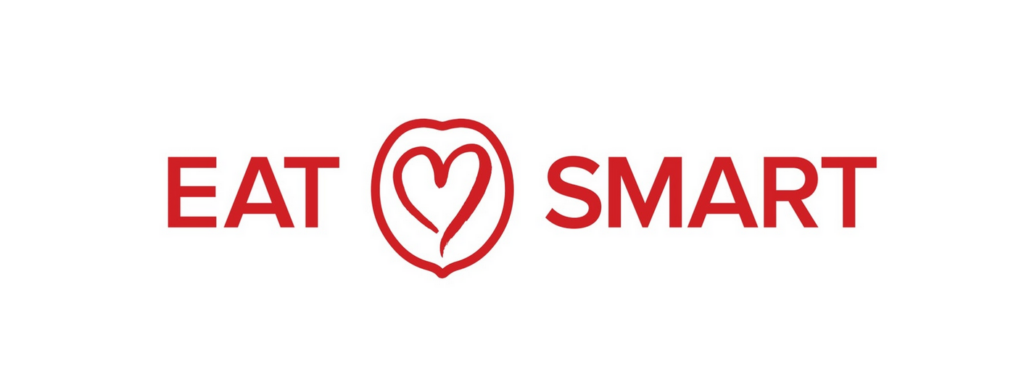
Eat Heart-Smart for American Heart Month
What is American Heart Month?
February is American Heart Month, a time the nation turns its attention to keeping families and communities free from heart disease, the No. 1 killer of American adult men and women. This federally designated event reinforces the importance of heart health and the need for more research, with a reminder to get families, friends and communities involved. It is a time to raise awareness about heart health and motivate Americans to adopt healthier lifestyles to help prevent heart disease.
–American Heart Association
Why is American Heart Month Important?
Although heart disease has multiple causes, adopting a healthier diet is one of the key actions people can take to combat it. American Heart Month is an ideal period to pause and take stock of food choices and eating behaviors, striving to phase out unhealthy habits and adopt better ones that can be sustained over the long term. And there are heart-healthy foods to be found in nearly every aisle of the grocery store! One great way to start is looking for the American Heart Association’s Heart-Check mark, which has been guiding shoppers to healthier choices for over 20 years.
–American Heart Association
Heart-Smart Snacks
- Greek Cucumber Walnut Bites:
Make heart-smart snacking simple with @cawalnuts this American Heart Month! These Greek Cucumber Walnut Bites are your new go-to snack. #eatheartsmart https://bit.ly/2NCQvFX
2. Sweet & Spicy Walnuts:
A handful of walnuts is a perfect snack to fuel your day, and these heart-smart Sweet and Spicy Walnuts from @cawalnuts will satisfy any appetite this American Heart Month: https://bit.ly/2JxfH2z
3. No-Bake Walnut, Cocoa, Cherry Bars:
Eat heart smart this #American Heart Month with @cawalnuts No-Bake Walnut, Cocoa, Cherry Bars: https://bit.ly/33glgHh
4. Maple Walnut Energy Balls:
Find heart smart, bite-sized bliss in the form of these Maple Walnut Energy Balls. Learn how to make them using @cawalnuts for American Heart Month: https://bit.ly/32evcjf
5. Herbed Cheese and Walnut Stuffed Mini Peppers:
Take a bite out of American Heart Month by snacking on these Herbed Cheese and Walnut Stuffed Mini Peppers from @cawalnuts: https://bit.ly/2WJpwwE
6. Cottage Cheese-Walnut Caprese Toast:
American Heart Month is the perfect excuse to make @cawalnuts’ Cottage Cheese-Walnut Caprese Toast every day. https://bit.ly/34v8MeY
Start the Day with a Heart-Smart Breakfast
- Sweet Potato Avocado Toasts with Walnuts:
A successful day starts with at breakfast! These Sweet Potato Avocado Toasts with @cawalnuts are the new American Heart Month staple: https://bit.ly/3dz0p7X
2. Banana Bread Overnight Oats:
Don’t let busy mornings ruin your American Heart Month goals. Banana Bread Overnight Oats from @cawalnuts are a simple meal-prep option. https://bit.ly/32anTJi
3. Walnut & Oat Crusted Veggie Egg Cups:
A heart smart breakfast is quick and simple with @cawalnuts’ veggies egg cups! Learn how to make them for American Heart Month: https://bit.ly/2PNia9I
4. Ricotta, Banana, Walnut, and Honey Toast:
This sweet toast is topped with ricotta, banana, honey, and @cawalnuts for a flavorful and satisfying American Heart Month snack so you can eat heart smart! https://bit.ly/2S8O0w5
5. Fluffy Banana Walnut Pancakes:
Nothing is sweeter to wake up to than a stack of fluffy pancakes! This recipe is made with egg whites and flavored with bananas and @cawalnuts for a delicious heart smart start to the day! https://bit.ly/2LLYlzD
6. Creamy Egg Cups:
Meal prep your heart smart breakfast with these egg cups, filled with vegetables, bacon bits, and of course crunchy @cawalnuts: https://bit.ly/3h1gdC5
Power Pear-ing for yo ur Heart: Walnut + Pear Recipes
- Walnut Pear and Avocado Bowl:
Celebrate American Heart Month by trying out this heart smart bowl topped with @cawalnuts and a tangy pear and avocado dressing: https://bit.ly/3lBkeOi
2. Walnut Pear and Oat Nuggets:
A bite-sized snack that’s fruity, nutty, and heart smart? @cawalnuts brings you the trifecta in this recipe for American Heart Month:https://bit.ly/2JxAeUx
3. Walnut Pear Quesadilla with Spicy Pear Salsa:
This Walnut Pear Quesadilla with an accompanying salsa is a perfect recipe to add some spice to your American Heart Month. Try out @cawalnuts zesty recipe as a snack today, and shop heart smart: https://bit.ly/2JFd7qK
4. Walnut Pear Yam Skillet:
American Heart Month calls for an indulgent, heart smart side dish that satisfies both sweet and savory palettes: https://bit.ly/2JIAUWM
Sides, Salads, & More!
- Power up with Plants Protein Box:
This American Heart Month, eat heart smart at lunch for a busy day using @cawalnuts. Try out their Power Up with Plants Protein Box: https://bit.ly/34rKhiS
2. Pear and Walnut Spinach Salad:
To eat heart smart, shop heart smart and start with the basics. @calwanuts’ Pear and Walnut Spinach Salad with a Citrusy Dressing is so simple to make, you’ll eat it all American Heart Month long: https://bit.ly/2QB65Dc
3. Roasted Vegetables with Walnuts, Basil, and Balsamic Vinaigrette:
With bell peppers, mushrooms, onions, and squash, this Roasted Vegetable dish from @cawalnuts will be a delicious addition to any table this American Heart Month. https://bit.ly/3lSXqKv
4. Walnut Broccoli Apple Slaw:
This slaw is accented with crunchy toasted @cawalnuts and sweet apples to create a side that’s perfect for American Heart Month. https://bit.ly/3mymqr3
5. Warm Cauliflower Tuna and Walnut Pasta:
This warm pasta dish is just what you need for American Heart Month. It’s packed full of protein, vegetables, and heart smart @cawalnuts. https://bit.ly/38jb5Fr
6. Lemony Tuna Walnut Zoodle Salad:
Full of flavor and heart smart goodies, this Lemony Tuna Walnut Zoodle Salad with @cawalnuts will complete your American Heart Month: https://bit.ly/3ak9pyi
*Supportive but not conclusive research shows that eating 1.5 ounces of walnuts per day, as part of a low saturated fat and low cholesterol diet and not resulting in increased caloric intake, may reduce the risk of coronary heart disease. (FDA) One ounce of walnuts offers 18g of total fat, 2.5g of monounsaturated fat, 13g of polyunsaturated fat including 2.5g of alpha-linolenic acid – the plant-based omega-3.

4 Reasons to Go Walnuts for Heart Health
Ellie Wilson
MS, RDN Manager, Lifestyle and Wellness
Can a handful of walnuts make a difference to heart health? Research shows that walnuts have a place in a HeartSmart eating plan. Check out these four tips from the California Walnut Board (where our excellent Market 32 walnuts are sourced.)
- Unique among nuts, walnuts contain the highest amount of the plant-based omega-3 alpha-linolenic acid (ALA) with 2.5 grams per ounce.
- One ounce of walnuts is a powerhouse of important nutrients for optimum health, including 4g of protein, 2g of fiber and a good source of magnesium (45mg).
- Walnuts are a whole food contributing many beneficial nutrients that support overall wellness from head to toe including the heart, brain and gut.
- Walnuts are certified heart-healthy*by the American Heart Association with the Heart-Check mark.
Walnuts are versatile – they can be used in almost any recipe that calls for nuts, and they can be added to almost any recipe to add flavor, crunch and nutrition benefits. They keep best when refrigerated, especially after packaging is opened, a good tip for maximizing shelf life and budgets. They get another layer of flavor when toasted – it deepens the nutty flavor and takes your recipes up a notch! Keep it simple by sprinkling on cereal, tossing a handful in a smoothie, or adding to a cake or quick bread. Find out more about walnuts, check out the history, farming and sustainability, as well as great, tested recipes here!
BOGO Alert! We can help you explore how much more you can do with walnuts – from Sunday, January 31 to Sunday, February 28th, buy 1 bag of Market32 Walnuts, and get $1 off Chobani Greek Yogurt 24 or 48 oz containers. Find the Market 32 Walnuts in the Produce Section. This yummy recipe adds savory Greek Yogurt and walnuts to banana quickbread – Enjoy!
*Supportive but not conclusive research shows that eating 1.5 ounces of walnuts per day, as part of a low saturated fat and low cholesterol diet and not resulting in increased caloric intake, may reduce the risk of coronary heart disease. (FDA) One ounce of walnuts o_ers 18g of total fat, 2.5g of monounsaturated fat, 13g of polyunsaturated fat including 2.5g of alpha-linolenic acid – the plant-based omega-3.

American Heart Month - 5 Tips to Eat With Your Heart in Mind
Ellie Wilson
MS RDN, Manager, Lifestyle and Wellness
February is American Heart Month, and at Price Chopper/Market 32, we have many resources and tools that can support your efforts to enjoy a Heartsmart lifestyle.
The 2020 Dietary Guidelines for Americans has a great tagline that can guide how you make food and health decisions – “Make Every Bite Count”. This energizer is meant to help you look at the food choices you make for the benefits they bring to eating well and preventing disease. That can be challenging for many reasons. We have some shortcuts in our stores and pharmacies that can help put smart choices, budgets and wellbeing together more easily.
- Start small by using the Know Your Colors nutrition guides at the shelf and the Shops Online section of the Price Chopper/Market 32 website. These guides highlight products that meet HeartSmart and Low Sodium criteria, making it quick and easy to find and check the label for the information you need. The coordinating colors make it easy to use – red for HeartSmart, yellow for Low Sodium, with many items having both! Learn more at on our website.
- Enjoy more seafood, especially omega-3 rich salmon, trout, and tuna. Seafood twice per week is recommended by the American Heart Association and Dietary Guidelines – reel in the benefits of the great fresh and frozen seafood options that go from pan to plate in less than 20 minutes!
- Add Market 32 walnuts to salads, snacks and meals with American Heart Association Certified Heart Healthy recipes featuring walnuts! Check out the display in Produce and find a great BOGO coupon for Chobani Greek Yogurts.
- Double up on produce intake, whether it be fresh, frozen or canned – all bring benefits and Americans have plenty of room to add more to meet daily recommendations. Explore new takes on traditional foods, such as lentil pasta – combined with regular pasta to add the flavor, fiber, protein and nutrient benefits of pulses, in an affordable and delicious way. Add some extra canned PICS No Salt Added tomatoes and PICS Canned Beans for a flavor, protein and veggie-boosted meal that is easy on your time and budget!
- It is easy to find Low Sodium tagged tomatoes and other items throughout the store – the Know Your Colors nutrition guide helps you see where you can trade up to low sodium ingredients that connect the dots to smart choices for recipes and family meals.
Our Pharmacy team has great resources and programs – learn more about how to check blood pressure at the PharmaSmart kiosk, and how the Pharmacy app can help you keep blood pressure and heart medications on track!

Heart Health: Who Should Take Aspirin and CoQ10
Megan Hwaszcz
Pharmacy Intern
How many of you can remember the saying an aspirin a day keeps the doctor away? Most of us can say yes within a few seconds. However, many of us don’t know that it may not be the case anymore. Previously, aspirin was either prescribed or self-prescribed to prevent heart attacks, stroke, or other cardiovascular events1,2. Recent studies have shown that it may be doing more harm than good. You may be asking yourself, wait I take a daily aspirin. But wait, this new recommendation does not apply to everyone.
These new findings do not apply to individuals who have history of heart disease, stroke, those who underwent bypass surgery, or those who had a stent placed1. Patients with diabetes and have at least one other heart disease risk may be started on a low dose aspirin by their healthcare provider2. If you fall into any of these categories, you should continue to take low-dose (81 mg) aspirin daily, or as recommended by your health care provider to prevent another event1.2. For healthy individuals, studies on taking a daily low-dose aspirin are not consistent so what is currently recommended is to avoid taking a low-dose aspirin as there is no clear benefit but rather more potential for harm; including but not limited to increased risk of bleeding1,2. If you fall into this category and feel like you could benefit from a low-dose aspirin, speak to your healthcare provider or local Price Chopper Pharmacist for more information.
If you are otherwise a healthy individual, you can protect yourself in other ways with healthy habits1. Three simple steps include eating a heart-healthy diet, participating in regular exercise, and controlling blood pressure and cholesterol1. Before taking a low dose aspirin, always ask your healthcare provider before starting!
Now onto the next heart health drug, CoQ10. Some of you may be thinking what is that? Coenzyme Q10, or CoQ10, is an antioxidant and natural substance found in your body with the highest amounts found in the heart, liver, kidneys, and pancreas3,4. Your body uses CoQ10 for growth and maintenance4. This is considered a dietary supplement and with dietary supplements, it is important to note that these are not federally regulated by the FDA.. There are many things that CoQ10 has been rumored to aid in; including the prevention of heart disease, reduction of heart failure symptoms, a decrease in high blood pressure, reducing the risk of complications after heart surgery, and reducing high cholesterol levels. Numerous studies have examined the effects of CoQ10 in these areas; however, were found to be inconclusive and unclear3.
Is CoQ10 safe to take? CoQ10 is assumed to be safe with few adverse effects4. It may be beneficial to treating conditions like congestive heart failure. But it is notably important to discuss with your healthcare provider before starting. With supplements, it is always important to ask your doctor or pharmacist before starting due to potential drug interactions. CoQ10 has a possible interaction with anticoagulants, like Coumadin or Jantoven, making them less effective and increasing the risk for a blood clot4.
Should you take CoQ10? If you fall into any of the categories listed above; high blood pressure, heart failure, recent heart attack, or heart disease, speak to your healthcare provider or local Price Chopper Pharmacist before starting to make sure it is safe for you to start!
References:
- Avoid daily aspirin unless your doctor prescribes it, new guidelines advise [Internet]. www.heart.org. 2020 [cited 26 August 2020]. Available from: https://www.heart.org/en/news/2019/03/18/avoid-daily-aspirin-unless-your-doctor-prescribes-it-new-guidelines-advise
- Should you take a daily aspirin for your heart? [Internet]. Mayo Clinic. 2020 [cited 26 August 2020]. Available from: https://www.mayoclinic.org/diseases-conditions/heart-disease/in-depth/daily-aspirin-therapy/art-20046797#:~:text=The%20U.S.%20Preventive%20Services%20Task,over%20the%20next%2010%20years.
- Coenzyme Q10 NIH [Internet]. Nccih.nih.gov. 2020 [cited 26 August 2020]. Available from: https://www.nccih.nih.gov/health/coenzyme-q10
- Coenzyme Q10 Mayo Clinic [Internet]. Mayo Clinic. 2020 [cited 26 August 2020]. Available from: https://www.mayoclinic.org/drugs-supplements-coenzyme-q10/art-20362602
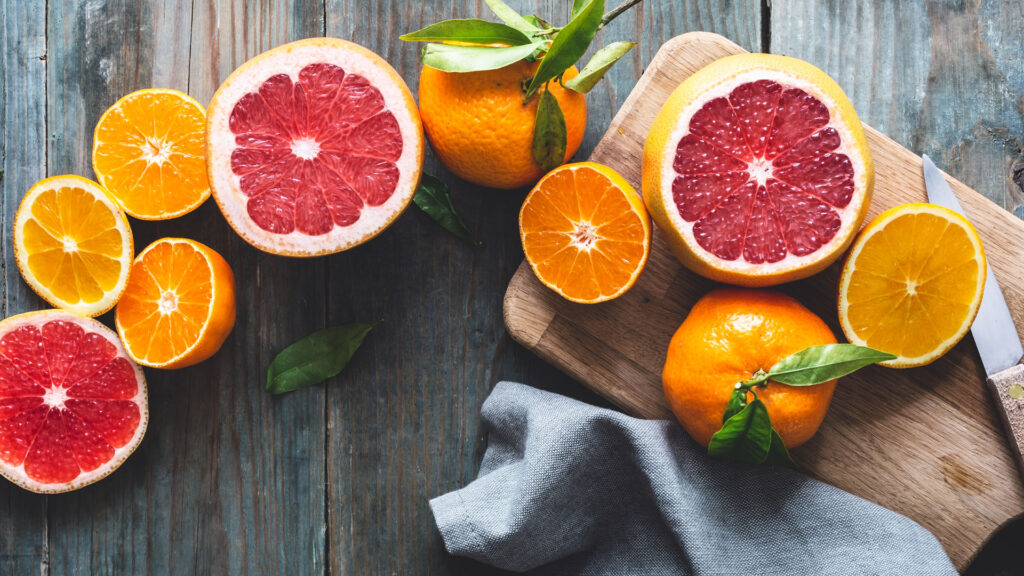
Citrus Celebration!
Mouthwatering, aromatic, energizing – Citrus is the genus name for the many varieties of delicious fruit we enjoy all year, and have in abundance when most are in season over the winter in North America.
The orange, perhaps the most well-known citrus fruit to Americans, is an ancient hybrid, a cross between a pomelo and a mandarin, thought to have originated in the region now known as Southern China and Northern India. The first mention of the sweet orange was in Chinese literature in 314 B.C.!
The fruit, juice and peel of the sweet orange are all flavor and benefit components of this citrus superstar – over 70% of citrus farming is for sweet oranges, per 2012 data. In 2017, 73 million tons of oranges were grown worldwide. Sweet oranges, including the Hamlin (juice oranges) and navel (easy-peel) oranges are grown in the USA in Florida and California.
The Citrus family includes oranges, Cara Cara oranges, blood oranges, lemons, Meyer lemons, limes, Key limes, mandarins, pomelos, tangerines, and tangelos – a beautiful, delicious and colorful family of fruits that bring aromatic flavor, color and texture to all types of meals and snacks. All are good sources of Vitamin C, essential to immunity and skin health. They also contain phytochemicals like polyphenols, terpenes and tannins – those active compounds have both health and flavor benefits, and research is ongoing to understand their full benefits.
The acidity of citrus fruits is the secret to their charm – the different levels of acidity bring flavor and balance to foods and recipes, and can create texture and tenderness. In order, from highest to lowest acid content, are lemons, limes, grapefruit and oranges. We will be sharing more blogs, culinary tips, science and health, recipes and more during this peak citrus season as it rolls out from January to April. Single and bagged displays and great values will help you energize your cart and your plate with fresh, delicious citrus fruits all season!
Kick off with this Citrus Glazed Fruit Salad recipe – squeezed fresh orange juice amps up the flavor, and you can mix in orange, mandarin and grapefruit segments anytime!
This Citrus Basil Spritzer is a sweet and herbaceous take on agua fresca sparkles with fresh flavors!
Pretty and delicious – this yummy Spinach Pomegranate Orange Salad with Quick Pickled Red Onions winter salad includes in-season oranges and pomegranates! Some fresh Pulled Roasters Rotisserie Chicken from the Food Service case makes it a meal!
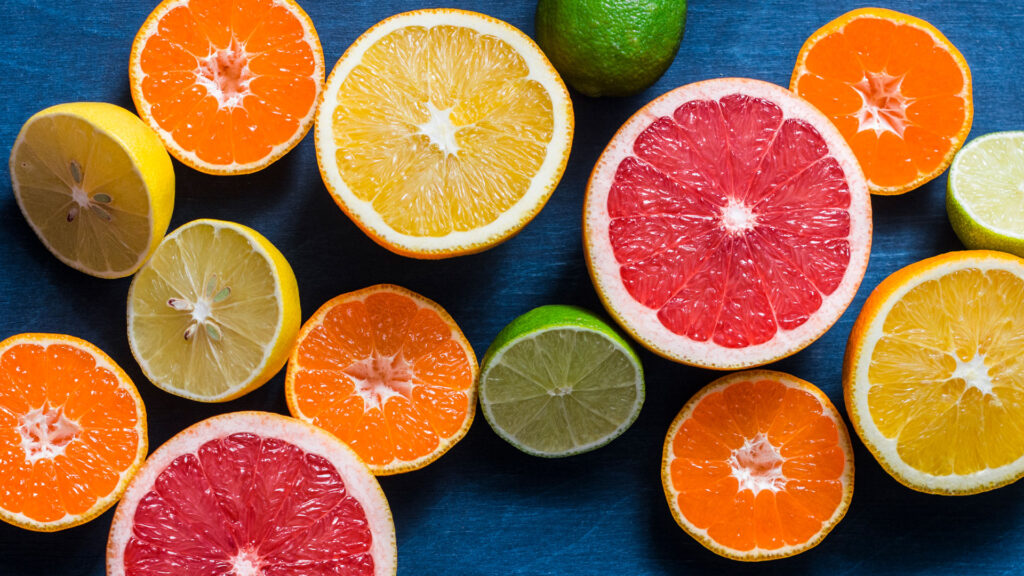
8 Ways to Love A Bag of Oranges (or Citrus)
Ellie Wilson
MS, RDN Manager, Lifestyle and Wellness
The cheery view of a bowl of fruit on your counter in the winter is also a good way to remind yourself (and your family) to eat more every day! Americans have plenty of room to enjoy more fruit as part of their healthy habits – here are some fresh ideas for enjoying a bag of oranges (and other bagged fresh citrus options) that will color your plate with great!
- Sweet and Simple – Peel a fresh navel orange and indulge in the fresh, juicy goodness! You can also slice them into wedges and share, a good idea for smaller children. Surprise them with the aromatic, juicy Cara Cara orange, with its spectacular rosy color! There may be a few seeds, so check before sharing!
- Slice any citrus fruit into rounds, and place on parchment paper on a sheet pan. Freeze, and then bag for use in water or as fun garnish for beverages, desserts, seafood – your call!
- If you are juicing an orange, or any other citrus, roll it first to max extracting juice from the pulp – the little juice vesicles in the fruit segments. That will ensure you get as much juice as possible. Then, toss the spent halves into a bag in the freezer, to use for zest and a few other ways we will share – keep reading! Check out the kitchen section in stores for great citrus press to make it easy!
- Segment an orange, mandarin, minneola tangelo, grapefruit or pomelo, and add to any fresh salad. Oranges, mandarins and tangelos pair beautifully with peppery arugula (rocket) greens and vibrant radicchio. Fresh baby spinach is mild and pairs with all citrus. Grapefruit and pomelos like sweet, buttery lettuces, with a sweet dressing, like a light raspberry vinaigrette. Check out your favorite fresh salad kit – add mandarin segments to chipotle cheddar, orange segments to honey pecan, and grapefruit to enhance poppyseed. A squeeze of fresh lemon on a bagged Caesar salad brings some added zing to that savory staple!
- Sweet salvage – Those leftover peels and halves are good for some, such as dried for potpourri (easy to drop into a small crockpot with a cinnamon stick!), or zested into sugar or salt and used for seasoning. For those who prep early – there is just enough acid in the spent citrus halves/peels to minimize browning in cut apple or potato – just drop one of the frozen halves in the water before you cook/serve them.
- Citrus serves up flavor, color and energy in spritzers, smoothies and spirits. Cocktail and mocktail drinks with lime, lemon and orange are plentiful, with quite a few on the recipes link at Pricechopper.com. Don’t forget the grapefruit – brighten up your day when you slice them up and garnish grapefruit drinks, sparkling waters, and grown-up only shandies and hard seltzers.
- Sassy salsas – Chopped orange, grapefruit, or mandarin, with some chopped onion, garlic and herbs (rosemary, parsley, cilantro, basil all work) and zest from the fruit make a super salsa topper for chicken, turkey, pork or seafood.
- Clean up time – If you are exploring cleaning with white vinegar, consider dropping a few solid peel slices into the vinegar first – they should infuse for about a week. The peel will release its acid and aroma into the vinegar, adding a little cleaning energy and fresh scent to the spray. A 50/50 mix of infused vinegar and water in a spray bottle will arm you with a fresh way to clean up!
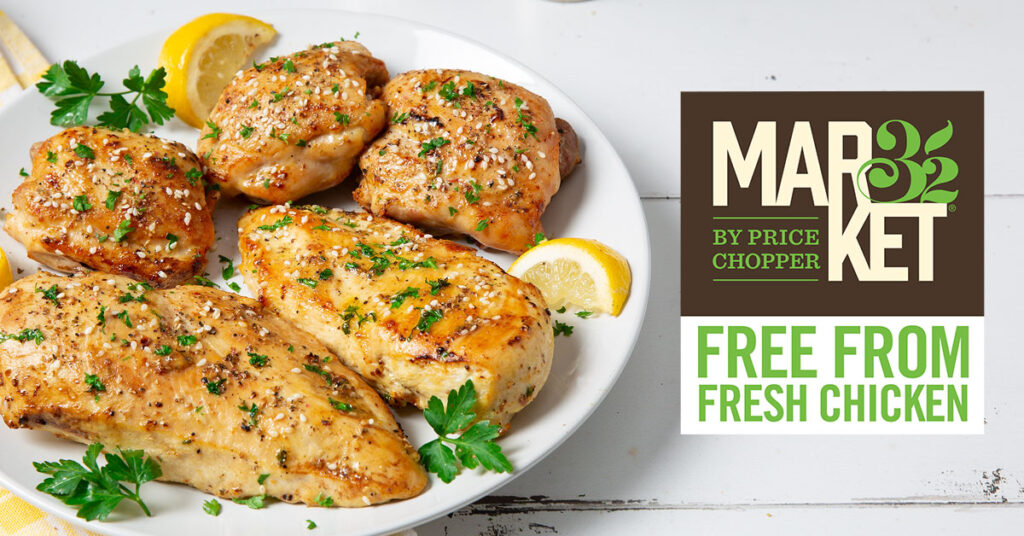
Winner, Winner, Market 32 Free From Chicken DInner
Ellie Wilson
MS, RDN
Chicken is definitely a winner when it comes to making a delicious dinner! Or lunch, or snack – versatile and available in so many easy-to-cook cuts, you can make tried and true family favorites, explore global cuisines, or just stick to quick and easy when Market 32 FREE FROM Chicken is on your list.
Market 32 FREE FROM Chicken has all of the flavor and quality shoppers are looking for – carefully sourced by the Market 32 FREE FROM Team from the first family farming operation in the world to earn the American Humane Certified ™ verification, they live in open houses, allowing them the ability to live a stress free life without the threat of predators, exposure to diseases from migratory birds or harm from the elements which would all impact flock health. They are fed a high quality diet of pesticide-free, American-grown, Non-GMO grains, specifically planned by vets and animal nutritionists, with an unlimited supply of clean water and fresh feed along with plenty of fresh air and room to roam. The farm has been raising chickens for over 50 years – they have learned that ensuring a good environment for the chickens, including water and soil testing, delivers a good quality of life and results in a safe, delicious product. They take even more care with their employees, which they call their best asset, ensuring they have company-provided PPE, regular screenings, work area safety standards, and more. Price Chopper/Market 32 customers can be confident they are bringing a great choice home to their families and friends.
Fresh Market 32 FREE FROM Chicken is an excellent source of protein and is also a lean choice when choosing skinless chicken tenders, thin-sliced cutlets or skinless chicken breasts. Market 32 FREE FROM Chicken is available in a range of cuts and package sizes, and lends itself to any number of recipes and serving ideas. Casseroles, soups, salads, sheet pan and skillet meals are all on the menu.

There has been a lot more cooking going on at home over the last six months or so, and we are hearing from customers that they are looking for some inspiration to get past cooking fatigue. We can help! Combine Market 32 FREE FROM Chicken with a delicious Culinary Tours item like Szechuan Style Peanut Sauce, or season with PICS Everything Spice Blend for a quick and easy meal. Check out the recipes below from our website and YouTube channels – you are sure to find some new favorites, and more than one way to win the dinner dilemma!
Honey Garlic Skillet Chicken | White Chicken Chili | Buffalo Chicken Salad | Salsa Verde Chicken Tacos

Kodiak Cakes - Energize a Protein and Whole Grain Habit!
Ellie Wilson
MS RDN Manager, Health and Wellness
New Year’s resolutions to embrace healthier habits inspire shoppers to look for new products and ideas. So many are working and managing school from home these days, I love finding solutions that connect the dots including easy-to-make, kid-friendly, travel-friendly, versatile and nutritious. The Kodiak Cakes products are delicious solutions with unique benefits to explore.
Power Cakes
The signature flapjack and waffle mixes, in Buttermilk and Honey or Dark Chocolate flavors, are a great starting place. Just add water, and these mixes will kick the day off with over 5 grams of protein per serving, (up to 14 gms in the Dark Chocolate mix!), 100% whole grains, and a good source of fiber to stay full and focused on the morning to-do list. Make extra and freeze them – they make a great lunch, snack or “breakfast-for-dinner” treat. These mixes can also be used for muffins, even batter for chicken nuggets or veggies (did someone say air fryer?). Bonus – both mixes earn the Know Your Colors nutrition guide tags for Protein Smart and Whole Grain!
Frozen Waffles and Flapjacks
The same whole grain goodness and even more convenience when you add these to the basket! Flavors adults and children love, and something older children/teens can make themselves, so super for beyond breakfast snack attacks! All three flavors – Buttermilk Vanilla, Dark Chocolate, and Blueberry Chia make the grade for Know Your Colors Whole Grain and Protein Smart.
Baking Mixes
You know you have a hit when your 17-year-old decides to make the protein-packed cornbread into muffins he can take to school! With 10 gms of protein per prepared serving, as well as 3 gms fiber and less than 10 grams of sugar, this item hits the mark and aligns with several of the healthier eating recommendations reinforced last week with the release of the new Dietary Guidelines for Americans – increase whole grain intake, increase fiber intake, and limit added sugars. Check out the whole line – the brownie and blueberry mixes are also made with whole grains, check the labels for more nutrition information and some great recipe variations on the side of the box.
Oatmeal Cups
Another hit with all age groups – these power 100% whole grain breakfast cups are easy and delicious, with flavors like Maple Brown Sugar – just add water (or milk, for a little extra nutrient boost) and cook in the microwave while coffee is brewing, they are also great for tweens and teens starting to cook, (placed strategically at the front of the pantry to inspire better after-school snacking on a cold day), and are a smart item to keep handy in a desk drawer at work for a power lunch. Bonus – they earn the Know Your Colors Protein Smart guide!
Granola Bars, Protein Balls and More
Kodiak Cakes is a company on a mission to bring whole grains, protein and flavor together in ways that really work for today’s health-seeking shoppers and families – check out their products throughout the store, for more solutions that will energize your whole grain and protein habits!
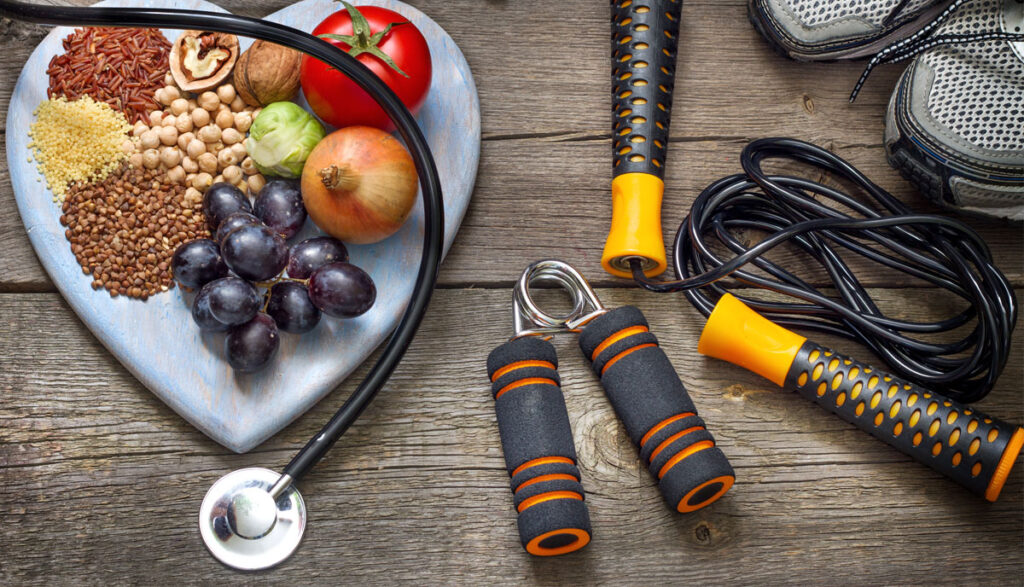
Think Lifestyle, Not Resolution
Antoni Favata
NASM-CPT, CES, CF-L1, FMS, SGX-OS
You hear about it year after year. Creating resolutions to begin a new year with a new you on Jan. 1. For a lot of people these resolutions focus around health and fitness.
However, most people with good intentions who set these realistic goals tend to lose steam and momentum come February.
So, what can we do to ensure our success with these not so lofty goals?
Here are a few tips to keep you on track and on target so you hit your mark and maintain your achievements for years to come.
- Think Lifestyle, Not Resolution
We often think of these resolutions in terms of extremes. Instead, we should think of these choices as a way of life and incorporate small changes every day. Change your mindset from “all or nothing” to “one day at a time.”
- Smaller, Manageable Habits
Small habits are not only more attainable, but easier to manage and maintain. Start with easier changes and build on them as they become regular practice. Smaller habits help you stay more motivated, too! Development and success of these smaller habits creates a growing sense of achievement as you get closer to a larger goal.
- Variety
It’s true, most of us struggle with having a short attention span. And for a lot of people that short attention span affects our fitness routine, which can derail progress. Even the word routine can be daunting for some. Fortunately, these days the Fitness Industry is not short on options. Keep exercise and movement fun by mixing up your routine. Subscribe to something new and exciting. Variety will help keep you on track by providing a new challenge to help keep your mind and body stimulated.
Instead of New Year’s resolutions set intentions instead, focusing on manageable lifestyle changes that will set you on a path to success.

Injection Perfection: Insulin 101
Emma Keating
Pharmacy Intern
Insulin is the hormone that your pancreas makes in order to help your body use the glucose (sugar) you ingest for energy. Without insulin, your body’s blood sugar levels can get too high and can lead to long term complications over time. In diabetic patients, insulin injections may be prescribed by your doctor as a part of an individualized treatment plan. While it sounds simple enough there are a lot of things come with insulin injections, so welcome to Insulin 101!
Self-Monitoring 1,2
When taking insulin, it is very important to check your blood sugar regularly as directed by your doctor. While having high blood sugar the problem we are trying to treat, injecting too much insulin can make your blood sugar too low. Low blood sugar, or hypoglycemia, can actually cause its own set of issues indicated by shaking, anxiety/confusion, sweating and chills, along with feeling dizzy. Usually, you will check your blood sugar before your first meal of the day. This is called a “fasting blood sugar” and the average goal is <100 mg/dL but can vary. Your blood sugar goal and the number of times you need to check it may change, so it’s very important to talk to your healthcare provider regularly!
Types of Insulin 3
There are several types of insulin based on how long it will work in your body or how quick it starts to work in your body. When you are first starting, it may take some time along with trial and error to find the dose that works for you.
- Ultra-Rapid Acting – begins to work within 12-20 minutes and lasts 1-3 hours4
- Insulin lispro-aabc (Lyumjev)
- Rapid Acting – begins to work 15-30 minutes after injection and lasts 2-4 hours
- Insulin lispro (Admelog, Humalog)
- Insulin aspart (Fiasp, Novolog)
- Insulin glulisine (Apidra)
- Short Acting – begins to work 30 minutes after injection and lasts 3-6 hours
- Regular insulin (Humulin R, Novolin R)
- Intermediate Acting – begins to work 2-4 hours after injection and lasts 12-18 hours
- Insulin NPH (Humulin N)
- Long Acting – takes several hours to start working, but lasts about 24 hours
- Insulin glargine (Basaglar, Lantus, Semglee)
- Insulin detemir (Levemir)
- Insulin degludec (Tresiba)
- Very Long Acting – starts working in 6 hours, lasts about 36 hours
- Insulin glargine, 300u/mL (Toujeo)
Injection Technique 1,2
Needle and Syringe – Using a needle and syringe means that you will have to draw up insulin from the vial. It is important to know your dose and how much you need prior to drawing up the medication. Afterwards, the insulin is injected under the skin (subcutaneously).
- Wash your hands prior to injecting medication.
- Choose the site to inject: back of the arms, the belly (except for 2 inches around the navel), front and outer side of the thighs, upper hip and upper outer area of the buttocks. Clean the area with an alcohol wipe.
- Pinch up a fold of the skin and quickly inject at a 90 degree angle (unless otherwise directed). Continue to pinch the skin and push the plunger down to inject the insulin. Do not inject medication through clothing.
- Hold in place for 5-10 seconds.
- Release the skin fold and remove the needle from the skin. If you can see insulin (clear fluid) or blood leaking from the injection site then press on the area for several seconds.
Pen Injectors – generally, insulin pens are easier to use as well as easier to bring places if you are on the go! The pen has a container that stores the insulin within it and a dial to preset the exact amount of insulin that you need. You will have to attach a new needle each time and it is very important to never share a pen or needle. The injection is given subcutaneously, using a similar technique to a regular syringe and needle. Instead of pushing down the plunger of the syringe, all you will have to do is push the button on the pen injector. Instructions for use can vary depending on the type of pen, so it is important to talk to your doctor, nurse or pharmacist about proper technique!
Storage 3
Keep your insulin in the fridge until you open it. Unopened vials and pens are good until the expiration date on the device. Once you open a vial or use a pen, keep them at room temperature in a safe, dry place. Avoid extreme temperatures – never store your insulin in the freezer, direct sunlight or in the car. Opened vials expire 1 month after they are opened. Usually pens expire 1 month after they are used, but this date can vary based on the type of device you have so be sure to read the label!
Tips & Tricks 1,2,3
Keep a notebook with all of your medicines and doses, including over the counter items, vitamins and supplements. Also keep track of your blood sugar readings and the amount of insulin you are injecting each day.
Having all of your medications sent to one pharmacy helps cut down on the risk for drug interactions or duplicate medications. This makes it easier for your pharmacist to ensure your medication safety!
It is very important to follow your insulin regimen as directed by your doctor and to not miss any insulin doses. Follow up with your healthcare provider if you have any questions or concerns regarding your treatment plan. Remember, be disciplined with your insulin!
SOURCES
- Weinstock RS, Nathan DM, Mulder JE. Patient Education: Type 1 Diabetes: Insulin Treatment Beyond the Basics [Internet]. 2020 [cited 2020 Aug 27]. Available from: https://www.uptodate.com/contents/type-1-diabetes-insulin-treatment-beyond-the-basics/print
- Wexler DJ, Nathan DM, Mulder JE. Patient Education: Type 2 Diabetes: Insulin Treatment Beyond the Basics [Internet]. 2020 [cited 2020 Aug 27]. Available from: https://www.uptodate.com/contents/type-2-diabetes-insulin-treatment-beyond-the-basics
- Medication Management: Insulin Basics [Internet]. 2020 [cited 2020 Aug 27]. Available from: https://www.diabetes.org/diabetes/medication-management/insulin-other-injectables/insulin-basics
- Introducing Lyumjev [Internet]. 2020 [cited 2020 Sept 1]. Available from: https://www.lyumjev.com/hcp/formulation



